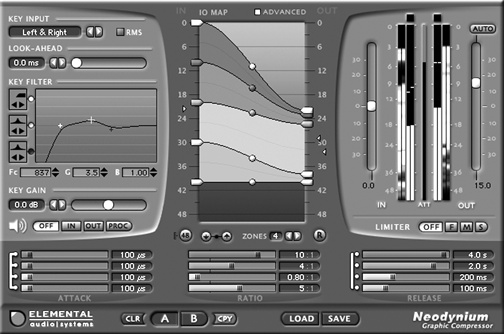by Steve Cunningham
Plug-ins, those little add-on software modules that extend the capability of a digital audio editor, are some of the most useful and innovative devices ever developed. Modern plug-ins often duplicate actual outboard hardware devices, particularly highly-prized vintage devices that are either wildly expensive or altogether unavailable. But some of the most interesting plug-ins are those that work in ways that their hardware counterparts never could.
Elemental Audio’s new Neodynium compressor falls into that category. Unlike a multi-band compressor that lets you set different compression levels for specific frequency bands, Neodynium lets you set different amounts of compression for specific volume levels in your audio track.
Like all of Elemental Audio’s plug-ins, Neodynium is available in both VST and Pro Tools-specific RTAS formats for Windows and Mac, and in Audio Units format for Mac. The compressor is highly efficient with CPU cycles, and you’ll find that you can run a number of them before experiencing any significant load on your computer.

A DIFFERENT ANIMAL
The usual goal of audio compression is to lower the volume of loud peaks, allowing the gain of the entire track to be raised without clipping. Most compressors work on an entire track to reduce its dynamic range by lowering the volume of peaks that exceed a preset level, called the Threshold. A Ratio control sets the amount of volume reduction that will be applied. Multi-band compressors first split the input signal into different frequency bands, using filters. Then each band runs through an independent compressor, and the results are mixed on the backside of those. This makes them useful for mastering finished tracks, for example when the bass needs taming without affecting the other frequencies.
Neodynium is a completely new device in the compression world. Instead of dividing the audio spectrum like a multi-band compressor, Neodymium takes an entirely different approach. Neodymium divides the dynamic range into bands or zones, and allows you to compress each zone separately. You can focus on specific level regions and compress them much differently than you do the others, which seems to me to be much more useful for radio than does multi-band compression, as we’ll see.

